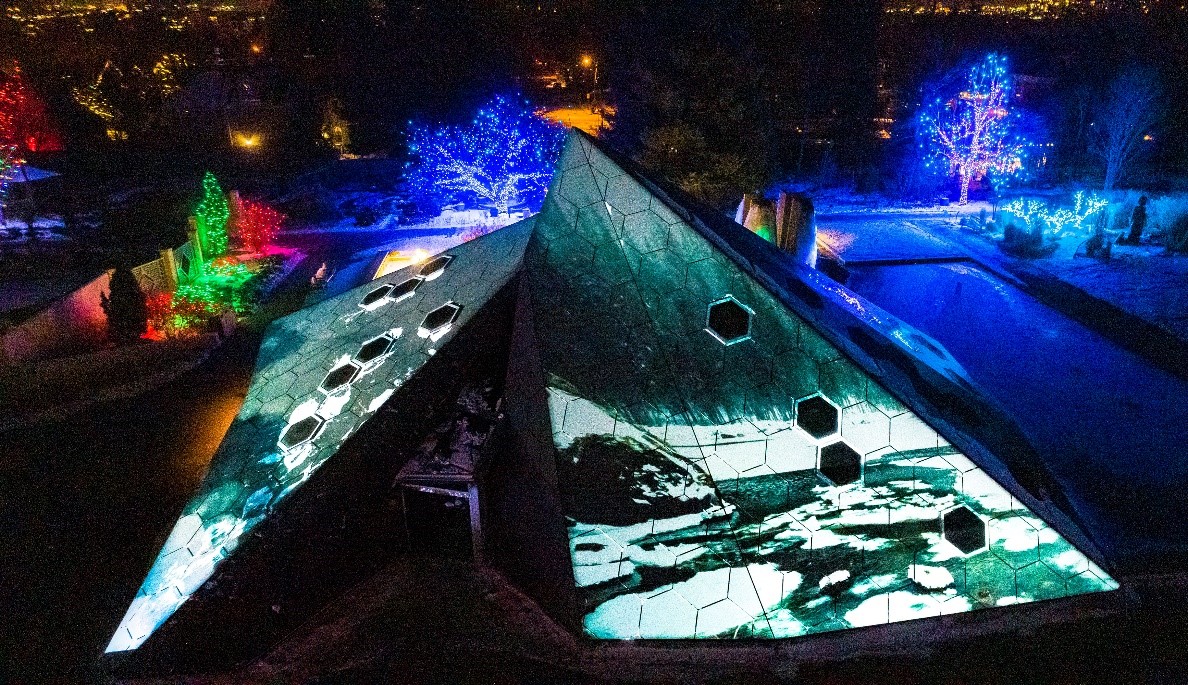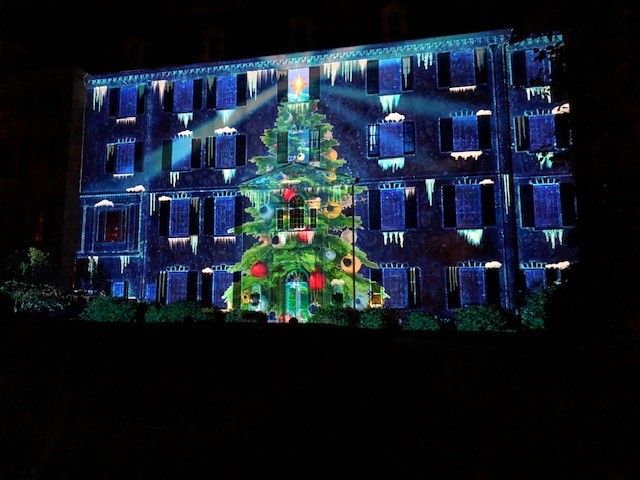With the holiday season upon us, many organizations are re-thinking their typical celebrations and opting for outdoor gatherings like holiday movie screenings, outdoor markets, and light displays. Leveraging the latest AV solutions such as laser projection technology can add a strong visual element to these events to keep audiences both engaged and safely distanced.
Incorporating projection mapped holiday characters onto statues, livestreaming Santa Claus onto a screen so children can safely engage and interact with him, and creating a virtual landscape that employs projection technology to interact with guests are a few ways organizations can re-imagine their holiday exhibits and festivities.
[The Technology Manager's Guide to Projectors and Screens]
While the options for outdoor events are limitless, there are also many factors to consider when choosing the right projection technology to deploy. Between preparing for weather hazards to aligning content with architecture challenges and lighting capabilities, event organizers and AV integrators must carefully consider the objectives of the project before deciding on specific equipment. Below are three factors to consider when planning your next outdoor holiday extravaganza.
Account for Environmental Factors
Outdoor spaces can be demanding, so it’s important to evaluate how well each individual projector can hold up to the environment in which it’s deployed. Will there be an overhang that can shield the projector from rain and snow? Is there an enclosure to house the projector and can it be controlled remotely?
Cold temperatures pose a unique challenge in the winter months and projectors installed in harsh environments demand reliable protection. When installing a projector outdoors, it’s critical AV integrators consider using an outdoor projector enclosure complete with a climate control system. This will help maintain the proper temperature and humidity levels to keep the projector running smoothly and its components free from condensation. Additionally, wind can shift screens and inhibit the viewing experience for guests, so event organizers and AV integrators should work together to ensure they are tightly secured.
Align Content and Outdoor Architecture for Strong Visuals
Outdoor exhibits that pair their content with the unique architecture and characteristics of a building can create amazing visual effects and experiences for guests, but they also require careful planning and coordination to determine proper projector positioning.
The texture of a building can often dictate projector placement to guarantee an even image. Irregular surfaces like stucco or brick require projectors to be installed as far back as possible to create a focused and crisp visual display. Using a projector with geometric correction will allow integrators and event organizers to adjust their projection mapping grid and correct surface abnormalities ensuring the content they are creating stays true to the desired design. Additionally, given the strong manual focus required to plan an outdoor holiday event, it’s best to use simple content and large images—think landscape settings, nativity scenes, or holiday icons—as opposed to small text or busy graphics.

In addition to texture, building architecture can pose some unique challenges. A pillar in front of a building, for instance, would require either additional projectors or one projector positioned far enough back for an even image across the entire building. Tall buildings can pose challenges too. Projectors are often situated at street level to cover the whole building, but this placement creates a large angle on the projected image referred to as Keystone distortion. While it is always important to have a projector with built-in “keystone correction” capabilities, it is better to physically reduce this distortion by mounting the projectors at a higher level to decrease the projection angle or by increasing the projection distance if it must remain at a lower level.
Sharpen Lighting to Make Content Shine
When envisioning an immersive outdoor holiday display, sharp lighting and vibrant colors come to mind. While lighting can pose challenges outside, close attention to detail can help avoid light spill and ensure engaging visuals for attendees.
[AV as Art: A Showcase of Projection Mapping]
When projecting images on an outdoor surface, placement is key to avoid pointing light in undesired areas, like attendees’ eyes, drivers passing by, or neighboring windows. It can be especially challenging to avoid light spill when projection mapping. For instance, projecting an image of Santa Claus on a statue will require a projector with strong masking capabilities to remove excess lighting around the statue’s edges.
While color quality should be precise when projecting indoors, projecting in an outdoor environment allows for additional creativity as the surface of an exhibit will dictate the quality of the colors. Therefore, it’s best to project content that is simplistic in design yet incorporates movements, like presents unwrapping themselves. Color contrast is also important to consider when examining content. At night there should be a high level of contrast with dark colors next to light colors, providing a strong visual experience for guests.
Capturing the Joy of the Season through Vibrant Visual Exhibitions
While holiday events will look a little different this year, professional AV solutions can play a key role in keeping audiences entertained and engaged. Choosing the right projector should be a careful, thoughtful process that considers environmental factors and precisely aligns content with architecture and lighting capabilities to ensure a safe and immersive event for all.

